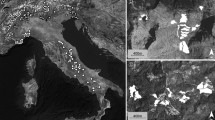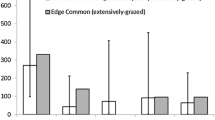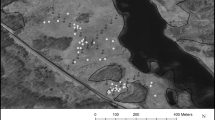Abstract
Ecotones are often species-rich and harbour specific resources and environmental conditions for invertebrates. Despite their functional significance for conservation, they are often not explicitly included in biotope typologies relevant to conservation policy and management (e.g., the European Habitats Directive). The Ilex Hairstreak (Satyrium ilicis) is a species of European conservation concern and a typical ecotone species inhabiting gradients from open (e.g., heathland, grassland) to closed vegetation (e.g., woodland). Here, we investigated its occurrence and habitat use at different spatial scales in Flanders (north Belgium). At a regional scale, species distribution modelling predicted 1,152 grid cells of 1 × 1 km2 to be suitable of which 190 were presumed to occur within colonization capacity (±2.5 km). At a local scale, adult butterflies were more abundant on sites sheltered by bushes and small trees and with nectar sources in the vicinity of tall oak trees (mate locating sites). For egg-laying, females preferred oaks of intermediate height (50–150 cm) with many low branches at some distance from the nearest woodland edge (12 m). Additionally, Alder Buckthorn (Frangula alnus) was abundant as well as a herb layer of 10–15 cm. 73 % of the eggs were parasitized and parasitism occurred more often within sites where small oaks were very abundant. Making use of our results, we suggest conservation measures at different scales for this endangered ecotone species: policy measures at a regional level to delineate functional conservation units and local management measures using a resource-based approach.





Similar content being viewed by others
References
Allouche O, Tsoar A, Kadmon R (2006) Assessing the accuracy of species distribution models: prevalence, kappa and the true skill statistic (TSS). J Appl Ecol 43:1223–1232. doi:10.1111/j.1365-2664.2006.01214.x
Araújo MB, New M (2007) Ensemble forecasting of species distributions. Trends Ecol Evol 22:42–47. doi:10.1016/j.tree.2006.09.010
Baguette M (2003) Long distance dispersal and landscape occupancy in a metapopulation of the cranberry fritillary butterfly. Ecography 26:153–160. doi:10.1034/j.1600-0587.2003.03364.x
Baguette M, Van Dyck H (2007) Landscape connectivity and animal behavior: functional grain as a key determinant for dispersal. Landscape Ecol 22:1117–1129. doi:10.1007/s10980-007-9108-4
Bates D, Maechler M, Bolker B (2012) Linear mixed-effects models using S4 classes. R package version 0.999999-1/r1780
Baxter SW et al (2011) Parallel evolution of Bacillus thuringiensis toxin resistance in Lepidoptera. Genetics 189:U675–U814. doi:10.1534/genetics.111.130971
Blakesley D, Buckley GP (2010) Managing your woodland for wildlife. Pisces Publications, Newbury
Bos F, Bosveld M, Groenendijk D, van Swaay CAM, Wynhoff I, De Vlinderstichting (2006) De dagvlinders van Nederland. Verspreiding en bescherming (Lepidoptera: Hesperioidea, Papilionoidea). Nederlandse Fauna 7. Nationaal Natuurhistorisch Museum Naturalis; KNNV Uitgeverij; European Invertebrate Survey, Leiden
Bourn NAD, Warren MS (1998) Species action plan. Black Hairstreak Satyrium pruni. Butterfly Conservation, Dorset
Cahenzli F, Erhardt A (2012) Enhancing offspring quality or quantity? Different ways for using nectar amino acids in female butterflies. Oecologia 169:1005–1014. doi:10.1007/s00442-012-2254-7
Choutt J, Turlure C, Baguette M, Schtickzelle N (2011) Parasitism cost of living in a high quality habitat in the bog fritillary butterfly. Biodivers Conserv 20:3117–3131. doi:10.1007/s10531-011-0151-8
Dennis RLH (2010) A resource-based habitat view for conservation. Butterflies in the British landscape. Wiley, Oxford
Dennis RLH, Sparks TH, Hardy PB (1999) Bias in butterfly distribution maps: the effects of sampling effort. J Insect Conserv 3:33–42. doi:10.1023/A:1009678422145
Dennis RLH, Shreeve TG, Van Dyck H (2003) Towards a functional resource-based concept for habitat: a butterfly biology viewpoint. Oikos 102:417–426
Dennis RLH, Dapporto L, Dover JW, Shreeve TG (2013) Corridors and barriers in biodiversity conservation: new perspectives from the resource-based habitat viewpoint for butterflies. Biodivers Conserv 22:2709–2734. doi:10.1007/s10531-013-0540-2
Dennis RLH, Dapporto L, Dover JW (2014) Ten years of the resource-based paradigm: the biotope-habitat issue and implications for conserving butterfly diversity. J Insect Biodivers 2:1–32. doi:10.12976/jib/2014.2.8
Dover JW, Sparks TH, Clarke SA, Gobbett K, Glossop S (2000) Linear features and butterflies: the importance of green lanes. Agric Ecosyst Environ 80:227–242. doi:10.1016/S0167-8809(00)00149-3
Elith J, Phillips SJ, Hastie T, Dudik M, Chee YE, Yates CJ (2011) A statistical explanation of MaxEnt for ecologists. Divers Distrib 17:43–57. doi:10.1111/j.1472-4642.2010.00725.x
Erdös L, Galle R, Kormoczi L, Batori Z (2013) Species composition and diversity of natural forest edges: edge responses and local edge species. Community Ecol 14:48–58. doi:10.1556/ComEc.14.2013.1.6
Erhardt A, Mevi-Schütz J (2009) Adult food resources in butterflies. In: Settele J, Shreeve T, Konvička M, Van Dyck H (eds) Ecology of butterflies in Europe. Cambridge University Press, Cambridge, pp 9–16
Fartmann T, Müller C, Poniatowski D (2013) Effects of coppicing on butterfly communities of woodlands. Biol Conserv 159:396–404. doi:10.1016/j.biocon.2012.11.024
Fichefet V, Barbier Y, Baugnée JY, Dufrêne M, Goffart P, Maes D, Van Dyck H (2008) Papillons de jour de Wallonie (1985–2007). Faune-Flore-Habitats n°4. Groupe de Travail Lépidoptères Lycaena, Département de l’Etude du Milieu Naturel et Agricole (SPW/DGARNE), Gembloux
Fichefet V et al (2011) Milieux ouvert forestiers, lisières et biodiversité. Faune - Flore - Habitats n°7. Service Public de Wallonie - Direction générale de l’Agriculture, des Ressources naturelles et de l’Environnement, Gembloux
Friedman J, Hastie T, Tibshirani R (2000) Additive logistic regression: a statistical view of boosting. Ann Stat 28:337–374. doi:10.1214/aos/1016218223
Garcia-Barros E, Fartmann T (2009) Butterfly oviposition: sites, behaviour and modes. In: Settele J, Shreeve T, Konvička M, Van Dyck H (eds) Ecology of butterflies in Europe. Cambridge University Press, Cambridge, pp 29–42
Gaston KJ, Rodrigues ASL, van Rensburg BJ, Koleff P, Chown SL (2001) Complementary representation and zones of ecological transition. Ecol Lett 4:4–9. doi:10.1046/j.1461-0248.2001.00196.x
Godefroid S, Phartyal SS, Weyembergh G, Koedam N (2005) Ecological factors controlling the abundance of non-native invasive black cherry (Prunus serotina) in deciduous forest understory in Belgium. For Ecol Manage 210:91–105. doi:10.1016/j.foreco.2005.02.024
Guisan A et al (2013) Predicting species distributions for conservation decisions. Ecol Lett 16:1424–1435. doi:10.1111/Ele.12189
Hastie T, Tibshirani R (1987) Generalized additive models: some applications. J Am Stat Assoc 82:371–386. doi:10.2307/2289439
Henry EH, Schultz CB (2013) A first step towards successful conservation: understanding local oviposition site selection of an imperiled butterfly, mardon skipper. J Insect Conserv 17:183–194. doi:10.1007/s10841-012-9496-x
Hochkirch A, Gartner AC, Brandt T (2008) Effects of forest-dune ecotone management on the endangered heath grasshopper, Chorthippus vagans (Orthoptera: Acrididae). Bull Entomol Res 98:449–456. doi:10.1017/S0007485308005762
Hodgson JA, Moilanen A, Bourn NAD, Bulman CR, Thomas CD (2009) Managing successional species: modelling the dependence of heath fritillary populations on the spatial distribution of woodland management. Biol Conserv 142:2743–2751. doi:10.1016/j.biocon.2009.07.005
Humphrey J, Ray D, Brown T, Stone D, Watts K, Anderson R (2009) Using focal species modelling to evaluate the impact of land use change on forest and other habitat networks in western oceanic landscapes. Forestry 82:119–134. doi:10.1093/forestry/cpn042
Jacobs I, Segers N, Vanreusel W, Van Dyck H, Maes D (2014) Wetenschappelijk basisrapport voor het Soortbeschermingsprogramma Bruine eikenpage (Satyrium ilicis) vol INBO.R.2014.1494759. Rapport van het Instituut voor Natuur- en Bosonderzoek. Instituut voor Natuur- en Bosonderzoek, Brussel
Jaggi C, Baur B (1999) Overgrowing forest as a possible cause for the local extinction of Vipera aspis in the northern Swiss Jura mountains. Amphib Reptil 20:25–34. doi:10.1163/156853899x00033
Knight AT, Cowling RM, Rouget M, Balmford A, Lombard AT, Campbell BM (2008) Knowing but not doing: selecting priority conservation areas and the research-implementation gap. Conserv Biol 22:610–617. doi:10.1111/j.1523-1739.2008.00914.x
Koschuh A (2004) Eifunde vom Pflaumenzipfelfalter Satyrium pruni (LINNAEUS, 1758) in der südlichen Steiermark (Österreich) (Lepidoptera: Lycaenidae). Nachrichten des Entomologischen Vereins Apollo, Neue Folge 25:181–184
Koschuh A, Fauster R (2005) Der Braune Eichen-Zipfelfalters Satyrium ilicis (ESPER, 1779) (Lepidoptera: Lycaenidae) in der Steiermark (Österreich). Beiträge zur Entomofaunistik 6:65–86
Koschuh A, Savas V (2004) Eifunde vom Braunen Eichenzipfelfalter Satyrium ilicis (ESPER, 1779) im Raum Graz (Steiermark, Österreich) (Lepidoptera: Lycaenidae). Nachrichten des Entomologischen Vereins Apollo, Neue Folge 25:155–158
Köstler W (2005) Das Eiablageverhalten des Eichenzipfelfalters Satyrium ilicis (ESPER, 1779) nördlich der Alpen - mit Anmerkungen zur Biologie der Präimaginalstadien (Lepidoptera: Lycaenidae). Galathea 21:47–54
Kotze DJ, Samways MJ (1999) Invertebrate conservation at the interface between the grassland matrix and natural Afromontane forest fragments. Biodivers Conserv 8:1339–1363. doi:10.1023/A:1008945302029
Laurijssens G (2005) Habitatkwaliteit, mobiliteit en ruimtegebruik bij de Bruine eikenpage (Satyrium ilicis) en de Eikenpage (Neozephyrus quercus). Eindverhandeling Universiteit Antwerpen, Universiteit Antwerpen, Antwerpen
Löffler F, Stuhldreher G, Fartmann T (2013) How much care does a shrub-feeding hairstreak butterfly, Satyrium spini (Lepidoptera: Lycaenidae), need in calcareous grasslands? Eur J Entomol 110:145–152
Luoto M, Kuussaari M, Toivonen T (2002) Modelling butterfly distribution based on remote sensing data. J Biogeogr 29:1027–1037
Maes D, Van Dyck H (2001) Butterfly diversity loss in Flanders (north Belgium): Europe’s worst case scenario? Biol Conserv 99:263–276. doi:10.1016/S0006-3207(00)00182-8
Maes D, Gilbert M, Titeux N, Goffart P, Dennis RLH (2003) Prediction of butterfly diversity hotspots in Belgium: a comparison of statistically focused and land use-focused models. J Biogeogr 30:1907–1920. doi:10.1046/j.0305-0270.2003.00976.x
Maes D, Vanreusel W, Talloen W, Van Dyck H (2004) Functional conservation units for the endangered Alcon Blue butterfly Maculinea alcon in Belgium (Lepidoptera: Lycaenidae). Biol Conserv 120:229–241. doi:10.1016/j.biocon.2004.02.018
Maes D, Vanreusel W, Jacobs I, Berwaerts K, Van Dyck H (2012) Applying IUCN Red List criteria at a small regional level: a test case with butterflies in Flanders (north Belgium). Biol Conserv 145:258–266. doi:10.1016/j.biocon.2011.11.021
Maes D, Vanreusel W, Van Dyck H (2013) Dagvlinders in Vlaanderen: nieuwe kennis voor betere actie. Uitgeverij Lannoo nv, Tielt
McCullagh P, Nelder JA (1989) Generalized linear models vol 2nd edition. Chapman & Hall, London
Merckx T, Berwaerts K (2011) What type of hedgerows do Brown hairstreak (Thecla betulae L.) butterflies prefer? Implications for European agricultural landscape conservation. Insect Conserv Diver 3:194–204. doi:10.1111/j.1752-4598.2010.00088.x
Mortelliti A, Amori G, Capizzi D, Cervone C, Fagiani S, Pollini B, Boitani L (2011) Independent effects of habitat loss, habitat fragmentation and structural connectivity on the distribution of two arboreal rodents. J Appl Ecol 48:153–162. doi:10.1111/j.1365-2664.2010.01918.x
Odum EP (1971) Fundamentals of ecology vol 3rd edition. W B. Saunders Company, Philadelphia
Phillips SJ, Dudik M (2008) Modeling of species distributions with Maxent: new extensions and a comprehensive evaluation. Ecography 31:161–175. doi:10.1111/j.0906-7590.2008.5203.x
R Core Team (2013) R: A language and environment for statistical computing, 3.0.2 edn. R Foundation for Statistical Computing, Vienna
Rhodes JR, McAlpine CA, Zuur AF, Smith GM, Ieno EN (2009) GLMM applied on the spatial distribution of koalas in a fragmented landscape. In: Zuur AF, Ieno EN, Walker NJ, Saveliev AA, Smith GM (eds) Mixed effects models and extensions in ecology with R. Springer, New York, pp 469–492
Ries L, Sisk TD (2004) A predictive model of edge effects. Ecology 85:2917–2926. doi:10.1890/03-8021
Ries L, Sisk TD (2008) Butterfly edge effects are predicted by a simple model in a complex landscape. Oecologia 156:75–86. doi:10.1007/s00442-008-0976-3
Ries L, Fletcher RJ, Battin J, Sisk TD (2004) Ecological responses to habitat edges: mechanisms, models, and variability explained. Annu Rev Ecol Evol Syst 35:491–522. doi:10.1146/annurev.ecolsys.35.112202.130148
Roep Y (2011) De Bruine eikenpage bespied. Vlinders 26:25–27
Roversi PF (2008) Aerial spraying of Bacillus thuringiensis var. kurstaki for the control of Thaumetopoea processionea in Turkey oak woods. Phytoparasitica 36:175–186. doi:10.1007/Bf02981330
Schumacher H (2011) Rote Liste und Artenverzeichnis der Schmetterlinge (Lepidoptera) - Tagfalter (Diurna) - in Nordrhein-Westfalen. In: Landesamt für Natur, Umwelt und Verbrouwherschutz NRW (eds) Rote Liste der gefährdeten Pflanzen, Pilze und Tiere in Nordrhein-Westfalen, 4. Fassung - Band 2: Tiere. Landesamt für Natur, Umwelt und Verbrouwherschutz NRW, Nordrhein-Westfalen, pp 1–6
Shaw MR, Stefanescu C, Van Nouhuys S (2009) Parasitoids of European butterflies. In: Settele J, Shreeve TG, Konvička M, Van Dyck H (eds) Ecology of butterflies in Europe. Cambridge University Press, Cambridge, pp 130–156
Smith TB, Kark S, Schneider CJ, Wayne RK, Moritz C (2001) Biodiversity hotspots and beyond: the need for preserving environmental transitions. Trends Ecol Evol 16:431. doi:10.1016/S0169-5347(01)02201-7
Stuhldreher G, Villar L, Fartmann T (2012) Inhabiting warm microhabitats and risk-spreading as strategies for survival of a phytophagous insect living in common pastures in the Pyrenees. Eur J Entomol 109:527–534
Swets JA (1988) Measuring the accuracy of diagnostic systems. Science 204:1285–1293. doi:10.1126/science.3287615
Termaat T, Veling K, Vliegenthart A (2010) Soortbeschermingsplan Bruine eikenpage Noord-Brabant. Wageningen, De Vlinderstichting
Thomaes A, Kervyn T, Maes D (2008) Applying species distribution modelling for the conservation of the threatened saproxylic Stag Beetle (Lucanus cervus). Biol Conserv 141:1400–1410. doi:10.1016/j.biocon.2008.03.018
Thomas JA, Simcox DJ, Clarke RT (2009) Successful Conservation of a Threatened Maculinea Butterfly. Science 325:80–83. doi:10.1126/science.1175726
Thomas JA, Simcox DJ, Hovestadt T (2011) Evidence based conservation of butterflies. J Insect Conserv 15:241–258. doi:10.1007/s10841-010-9341-z
Thuiller W, Georges D, Engler R (2012) biomod2: ensemble platform for species distribution modeling. R package version 1.3.7/r529
Titeux N, Maes D, Marmion M, Luoto M, Heikkinen RK (2009) Inclusion of soil data improves the performance of bioclimatic envelope models for insects species distributions in temperate Europe. J Biogeogr 36:1459–1473. doi:10.1111/j.1365-2699.2009.02088.x
Tshikolovets V (2011) Butterflies of Europe & the Mediterranean Area. Tshikolovets Publications, Pardubice
Turlure C, Van Dyck H (2009) On the consequences of aggressive male mate-locating behaviour and micro-climate for female host plant use in the butterfly Lycaena hippothoe. Behav Ecol Sociobiol 63:1581–1591. doi:10.1007/s00265-009-0753-2
van Halder I, Barbaro L, Jactel H (2011) Conserving butterflies in fragmented plantation forests: are edge and interior habitats equally important? J Insect Conserv 15:591–601. doi:10.1007/s10841-010-9360-9
van Swaay CAM et al (2011) Applying IUCN criteria to invertebrates: How red is the Red List of European butterflies? Biol Conserv 144:470–478. doi:10.1016/j.biocon.2010.09.034
Vanreusel W, Van Dyck H (2007) When functional habitat does not match vegetation types: a resource-based approach to map butterfly habitat. Biol Conserv 135:202–211. doi:10.1016/j.biocon.2006.10.035
Veling K (2006) Bruine eikenpage knijpt er stiekem tussenuit. Vlinders 21:4–6
Veling K, Smit J, Siebering V (2004) Bosrandbeheer voor vlinders en andere ongewervelden. Vereniging voor veldbiologie (KNNV), Utrecht
Vriens L et al (2011) De Biologische Waarderingskaart. Biotopen en hun verspreiding in Vlaanderen en het Brussels Hoofdstedelijk Gewest. Mededelingen van het Instituut voor Natuur- en Bosonderzoek. Instituut voor Natuur- en Bosonderzoek, Brussel
WallisDeVries MF (2008) Aandacht voor de bruine eikenpage in Kennemerland vol Rapport VS2008.005. De Vlinderstichting, Wageningen
Warren MS (1987) The ecology and conservation of the Heath fritillary butterfly, Mellicta athalia. III. Population dynamics and the effect of habitat management. J Appl Ecol 24:499–513. doi:10.2307/2403889
Zuur AF, Ieno EN, Walker NJ, Saveliev AA, Smith GM (2009) GLMM and GAMM. In: Zuur AF, Ieno EN, Walker NJ, Saveliev AA, Smith GM (eds) Mixed effects models and extensions in ecology with R. Springer, New York, pp 323–341
Acknowledgments
We are grateful to the many volunteers who helped with the surveys and to the wardens of the National Park Hoge Kempen (Jos Gorissen) and the Visbeek-Kindernouw nature reserve (Werner De Kinderen) who kindly gave us access to the respective areas. Part of the study was financed by the Agency for Nature and Forest (ANB—Flemish Government) as a species action plan for the Ilex Hairstreak in Flanders (north Belgium). We also thank two anonymous reviewers and Marc Pollet for useful comments on an earlier version of the manuscript.
Author information
Authors and Affiliations
Corresponding author
Electronic supplementary material
Below is the link to the electronic supplementary material.
Rights and permissions
About this article
Cite this article
Maes, D., Jacobs, I., Segers, N. et al. A resource-based conservation approach for an endangered ecotone species: the Ilex Hairstreak (Satyrium ilicis) in Flanders (north Belgium). J Insect Conserv 18, 939–950 (2014). https://doi.org/10.1007/s10841-014-9702-0
Received:
Accepted:
Published:
Issue Date:
DOI: https://doi.org/10.1007/s10841-014-9702-0




